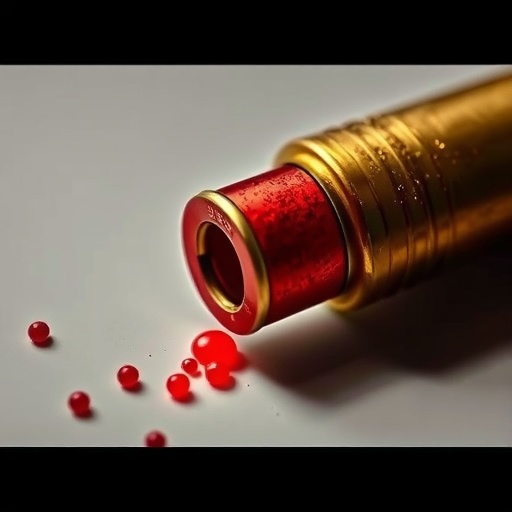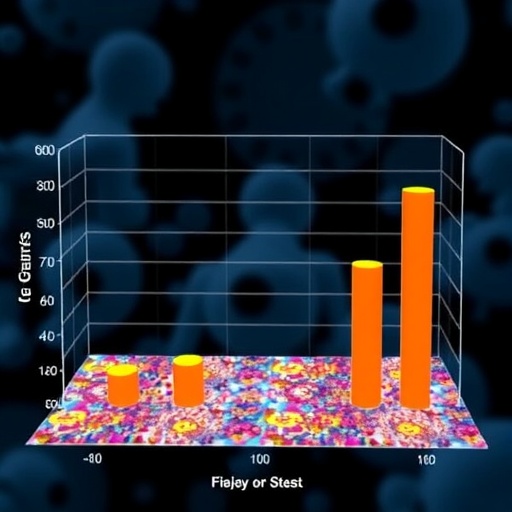In the continuously evolving field of forensic science, the quest for innovative methods to detect crucial evidence with higher precision remains relentless. One of the paramount concerns in forensic investigations is the accurate identification of gunshot residues (GSR), a vital element in reconstructing shooting incidents and determining shooter proximity. A groundbreaking study recently published by Bottoni, Wittig, Rost, and colleagues presents a novel approach to detecting gunshot residues through the application of infrared (IR) photography, examining factors such as ammunition type, surface coloration, and the complicating presence of blood contamination. This advancement may revolutionize forensic protocols by enhancing the reliability and scope of GSR detection in complex crime scene environments.
Gunshot residues have traditionally been detected using chemical analyses and microscopy-based techniques, relying on elemental composition and particle morphology. However, these methods often face limitations concerning surface reflectivity, background interference, and the presence of biological contaminants like blood, which can obscure or degrade residue visibility. The research team focused on infrared photography as a complementary, non-destructive imaging modality, recognizing its potential to penetrate surface layers and differentiate materials based on their specific infrared absorption and reflectance spectra.
Infrared imaging capitalizes on the interaction of infrared light with matter, capturing contrasts invisible to the human eye. By fine-tuning wavelengths and using dedicated IR filters, forensic experts can identify subtle differences in residue deposits that may go unnoticed under visible illumination. In this study, the investigators meticulously analyzed how the spectral signatures of GSR vary depending on ammunition composition, surface properties, and contamination, aiming to define IR imaging protocols that optimize residue detection accuracy.
A significant variable scrutinized in the study was the type of ammunition used. Ammunition composition directly affects the chemical makeup of deposited residues, which consequently alters the infrared reflective patterns captured by the camera sensor. Traditional full-metal-jacket bullets, lead-based rounds, and specialized ammunition such as frangible or coated projectiles produce differing particulate residues. The study demonstrated that these compositional differences manifest distinctly within the infrared spectrum, allowing differentiation not only of residue presence but also inferential identification of ammunition type—a potential leap in forensic pinpointing capabilities.
The surface material on which gunshot residues settle further complicates detection under both visible and infrared modalities. The researchers explored various common crime scene substrates, including fabrics of diverse colors, metals, painted surfaces, and human skin mimetics. Coloration impacted IR reflectance, with darker-colored surfaces absorbing infrared light more readily and sometimes masking residue signatures. Contrastingly, lighter or reflective surfaces altered scattering patterns. The ability of infrared photography to adapt through adjustable wavelength bands proved critical in addressing these challenges, facilitating enhanced residue visualization across a broad spectrum of surface types.
Blood contamination represents a frequent and formidable obstacle in forensic residue detection, especially in violent shooting scenarios. Biological fluids not only physically obscure residue particles but also introduce complex chemical backgrounds that can mislead elemental or spectral analyses. The research innovatively tested residue visibility on surfaces smeared with varying quantities of blood, assessing how infrared imaging performance was impacted. Results revealed that certain IR wavelength windows penetrated the blood layer more effectively, recovering residue details otherwise concealed under visible light examination, thereby expanding forensic toolkits for crime scenes involving bodily fluids.
The methodology involved a rigorous experimental setup where various ammunition types were fired onto differently colored substrates, both dry and contaminated with controlled volumes of simulated blood. High-resolution infrared cameras equipped with interchangeable filters captured the resultant images. Researchers applied image enhancement algorithms and spectral analysis to quantify residue detection sensitivity and specificity under each condition, enabling a comprehensive evaluation of IR photography’s forensic utility.
One of the emergent findings highlighted the adaptability of multispectral infrared imaging systems to discern gunshot residue amidst complex visual noise. By leveraging specific wavelength bands tailored to the unique absorption characteristics of GSR chemical components, forensic specialists can circumvent the visual obfuscation imposed by surface colors and blood overlays. This capability marks a distinct evolution from traditional monochromatic or visible-light-based imaging approaches, pushing the boundaries of non-invasive residue detection.
Moreover, the study underscores the practicality of infrared photography as an on-site forensic tool. Unlike some laboratory-intensive chemical tests requiring sample collection and processing, IR imaging can be executed rapidly and non-destructively at the crime scene, preserving evidence integrity while providing immediate analytical insights. This advantage may accelerate investigative workflows and improve evidentiary documentation fidelity during initial evidence gathering phases.
Technological improvements in infrared sensors, accompanied by the integration of machine learning for image analysis, were noted as promising avenues for further enhancing GSR detection efficacy. Automated pattern recognition models trained on extensive IR residue image datasets could facilitate objective, standardized assessments, reducing human subjectivity and increasing reproducibility in forensic interpretations.
However, the authors prudently acknowledge limitations inherent to infrared photography in this application. Highly absorbent or irregular surfaces may still pose detection challenges, and environmental variables such as ambient temperature and lighting conditions can affect image quality. The study calls for continued research to refine IR imaging protocols and develop standardized guidelines ensuring consistent application across diverse forensic contexts.
This investigation opens a new frontier in forensic ballistics, demonstrating that infrared photography can transcend conventional limitations imposed by surface and contaminant variables. The ability to detect and characterize gunshot residues with enhanced clarity and contextual understanding holds promise not only for improving court-admissible evidence but also for delivering timely and accurate investigative leads critical in criminal justice.
The interdisciplinary nature of this research—bridging photonics, material science, and forensic chemistry—showcases how innovation at scientific crossroads can yield transformative tools for law enforcement. As infrared imaging technologies become more accessible and affordable, their widespread adoption could democratize advanced forensic capabilities, empowering investigators worldwide to uncover hidden evidence with unprecedented precision.
In sum, Bottoni and colleagues’ pioneering work validates the influential role of ammunition type, substrate color, and blood contamination in shaping gunshot residue detectability via infrared photography. Their comprehensive evaluation provides a roadmap for optimized imaging approaches tailored to diverse forensic scenarios, marking a significant milestone in the evolution of non-destructive crime scene investigation methodologies.
Future research building upon these findings might explore integration with complementary modalities such as hyperspectral imaging and Raman spectroscopy, potentially enabling multiplexed chemical and spatial analyses of residues. The convergence of these techniques could pave the way for holistic forensic platforms capable of delivering rapid, multidimensional evidence profiles crucial for solving increasingly complex shooting cases.
With forensic science continually striving to maintain pace with technological advancements and criminal ingenuity, the introduction of refined infrared imaging protocols promises to be a game-changer. Enhancing the detection of gunshot residues not only aids in reconstructing shooting incidents accurately but also strengthens the evidentiary foundation for delivering justice reliably and swiftly.
Subject of Research: Detection of gunshot residues using infrared photography with consideration of ammunition type, surface color, and blood contamination.
Article Title: Detection of gunshot residues using infrared photography: influence of ammunition type, surface color and blood contamination.
Article References:
Bottoni, J., Wittig, H., Rost, T. et al. Detection of gunshot residues using infrared photography: influence of ammunition type, surface color and blood contamination. Int J Legal Med (2025). https://doi.org/10.1007/s00414-025-03609-9
Image Credits: AI Generated
Tags: advancements in forensic science technologyblood contamination in forensic analysischallenges in complex crime scene investigationsenhancing reliability of forensic protocolsgunshot residue detection methodsimpact of ammunition types on GSRinfrared light interaction with materialsinfrared photography in forensicslimitations of chemical analysis in GSR detectionnon-destructive imaging techniquesreconstructing shooting incidents through evidencesurface coloration effects on residue visibility





